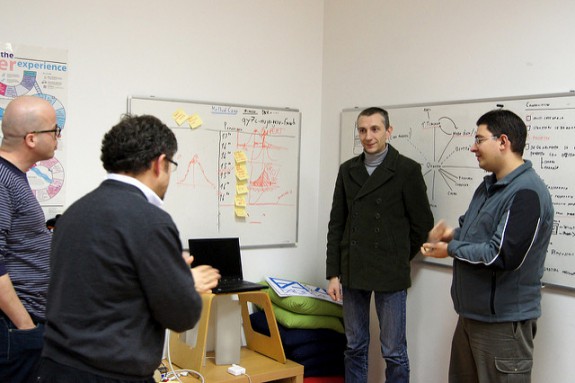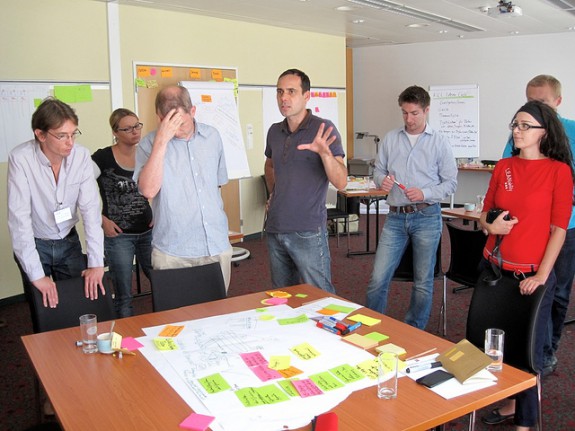What is Agile Project Management?
Imagine having a software development methodology that will make you pass through all the gates once you go back and correct something during the course of the project. That really sounds tough. How about having to open just one gate and then come back through the same one, without having to disturb other gates?
Suppose you have a large project, with the client not very sure about what he wants? And you can test the project only after the entire process is completed. Does this sound like the Waterfall method?
The Waterfall method is the traditional method of testing projects. The testing was done in the sequential order so the team could go to the next phase of development only after clearing the previous steps. But it did have a number of problems, like you cannot change the requirements once you start on the project, the Testing phase comes only after the Build phase and so on.
How do you solve problems like these and how do you make it flexible? By following Agile Project Management.
Agile Methodology is a practice that aids in the continuous iteration of development and testing. It is most suitable for big projects in short development cycles known as ‘sprints’.
There are different agile project management roles, and some do not include a project manager. In Agile methodology, the roles and responsibilities are shared between the Scrum Master and the product owner. It is a kind of approach that delivers requirements interactively and incrementally throughout the course of the project.
The main difference between traditional project management and agile methodology is that the former presents with a detailed plan that should be followed thoroughly throughout the course of the project. In Agile, the requirements (from the client, mainly) could change, and that’s why it’s flexible nature is so useful in a project. This is because software project requirements are bound to change as per the market demand. Clients may not always be able to finalise requirements before the prototype is out, so going the agile route may be the only life-saving strategy here.
Agile Project management is all about ‘embracing change’ because software projects can be completed only when you can understand what customers need, requirements can change even quite late in the development stage.
Agile reduces project complexity by breaking down the project into sprints, with each sprint broken down into cycles of few weeks each.
Embrace these things to become truly Agile in your company:
1. Truly Agile, means taking the company as a whole
If you want to be Agile, you have to know how, when, where to do it. It is important to be transparent from the top management level to the lowest hierarchy so everyone is aware of the objectives of the organisation. Each member of the team must be encouraged to solve their problems, sharpen their skills, so there is lifelong learning throughout.
2. Work in sprints
As explained earlier, Agile techniques is based on sprints. In the traditional methodology, i.e. the waterfall method, huge levels of planning go into the project, but it is all rigid. You cannot pause and look back at what you have done, because you are running a marathon here. You can stop only at the finishing point. By being agile, you have short sprints, so you can go back and correct the mistakes you’ve made. If the project requirements have changed, you can accommodate those as well.
3. Retrospective at the Sprint level
By doing retrospection, you can do a feedback loop at the sprint level. This helps the team to perform evaluation of their performance and past actions. At this stage, the team members will go through the existing ideas, and compare them with new ideas to see if any changes are to be made. At the retrospection stage, the following questions are asked:
- How did things go in the last iteration?
- What went wrong?
- What are the ways to rectify it, and what measures should be taken to avoid them
Retrospection helps the team to stay on the right track.
4. Go Agile in the hiring process
When adding more people to your team, it would be great if you could hire people who are familiar with agile methodology. This way, you can easily deploy them into your system easily, and there is no need to teach them the reins of the game. It would help the team to work collaboratively towards realising company goals. The only thing is to make sure that the newcomers have the skills to adapt to the team’s demands.
5. An environment of continuous learning
When you go Agile, your company transforms and your team gets involved in a continuous learning environment. This is one of the core components of an agile organisation, because without continuous improvement, you cannot go fully Agile. An environment of continuous learning will help in faster Time to Market and better product cycles. Once Continuous Improvement is generated, Retrospection becomes smoother, the product attains a better position for release and your business gets poised for success.
6. Turning into a Kaizen organisation
Kaizen is the Japanese term for ‘good change’. By practicing agile methodology, there is constant improvement and change, and this runs hierarchically, right from the CEO to the entry-level employee in the company. Through Kaizen, the company becomes a better place to work, where people innovate and test new ideas, where there are opportunities for improvement at every stage. Kaizen makes it possible to consider problems as windows of opportunities, not as closed doors.
Closing Thoughts
Through Agile product development, the highest priority is customer satisfaction, with changing environments seen as an opportunity to bring the product to a competitive advantage. Both the stakeholders and the developers foster a new kind of relationship and works closely on a daily basis.
Agile makes it possible to have minimal wastage of resources, with faster turnarounds, of course. Here are the popular agile methodologies you can use in your organisation – Scrum, Kanban, Lean, Dynamic System Development Model, Crystal, Scrumban, Rapid Application Development and Feature Driven Development.
Interesting Articles:
How this type of project management will work for your team
How agile projects are managed
Picture Source: Flickr.com/ Luca Mascaro/ visualpun.ch



